Lenovo Yoga Slim 7x review: the Snapdragon superstar
With Qualcomm's Snapdragon X Elite laptops becoming more readily available, here's arguably the best one of its type

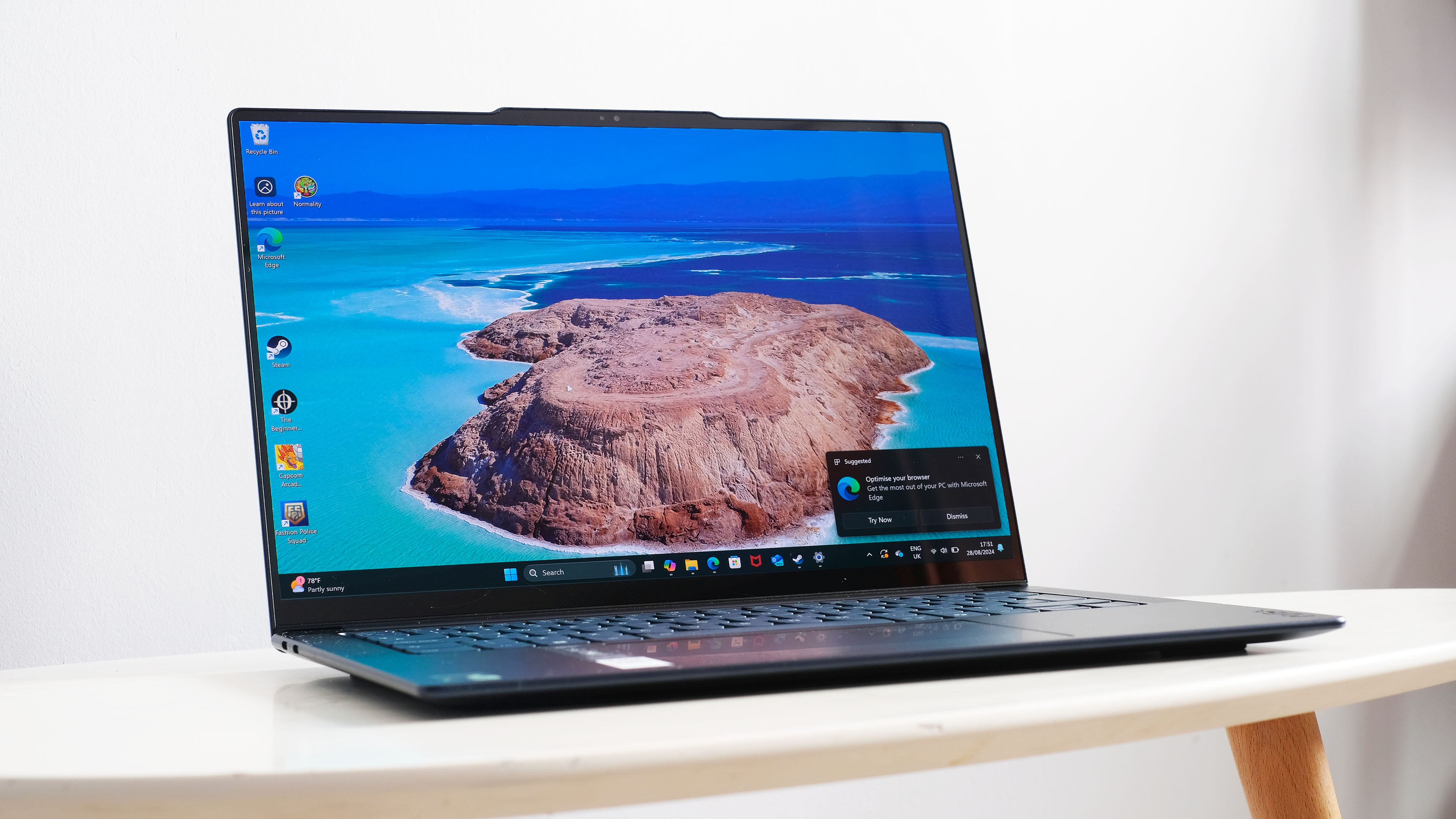
We’re not persuaded everyone needs a made-for-AI laptop. But the Lenovo Yoga Slim 7x makes a pretty compelling case as the best pick for those seeking one. The pricing is sensible, particularly for upgrades, the external hardware is great, the keyboard’s a delight, and battery life for light work is fab.
-
+
Excellent, substantial-feeling keyboard
-
+
Long battery life for light work
-
+
Glass touchpad feels great
-
-
Buying a laptop of this style requires a little faith
-
-
No headphone jack and speakers could be better
-
-
Not the most rigid display
Why you can trust T3

The Lenovo Yoga Slim 7x is part of the first wave of "made for AI" laptops, boasting Qualcomm's Snapdragon X Elite platform inside.
Is this a new era of computing when it comes to the best laptops or just the latest play from the marketing department? It's more of the latter, to be honest, but all of these laptops are still killer buys for anyone seeking a super-portable and powerful Windows laptop. And the Lenovo Yoga Slim 7x is probably my favourite of the AI bunch so far, as I'll explain in this review.
I've looked at a number of these laptops already. The Lenovo Yoga Slim 7x hits the "just right" sweet spot in almost every area. And while some of this is down to personal takes – with which not all of you will align– I'll be breaking this one down piece by piece. This is no Lenovo Yoga hype article, but the Yoga Slim 7x sure is a great laptop.
Lenovo Yoga Slim 7X: Price & Availability
The Lenovo Yoga Slim 7x launched alongside the rest of the first-wave Co-Pilot Plus AI laptops in June 2024.
There are three key models in the line-up. The base one costs £1250/$1199 and has 16GB RAM and a 512GB SSD. Most folks will probably be just fine with this one, and all of them use the higher-end Snapdragon X Elite chipset.
One step up, the Lenovo Yoga Slim 7x is available with 16GB RAM and a 1TB SSD, for £1299/$1289. Or with 32GB RAM for a little more. Compared to the amount Apple and Microsoft charge for such upgrades, this represents a bargain. But Lenovo laptops tend to see more sales and discounts than the best MacBooks or Surface laptops, so do some price research to be sure.
Direct from Lenovo you can also pay an additional sum for Windows 11 Pro rather than Windows 11 Home. But you probably don’t need it.
Lenovo Yoga Slim 7X review: Design
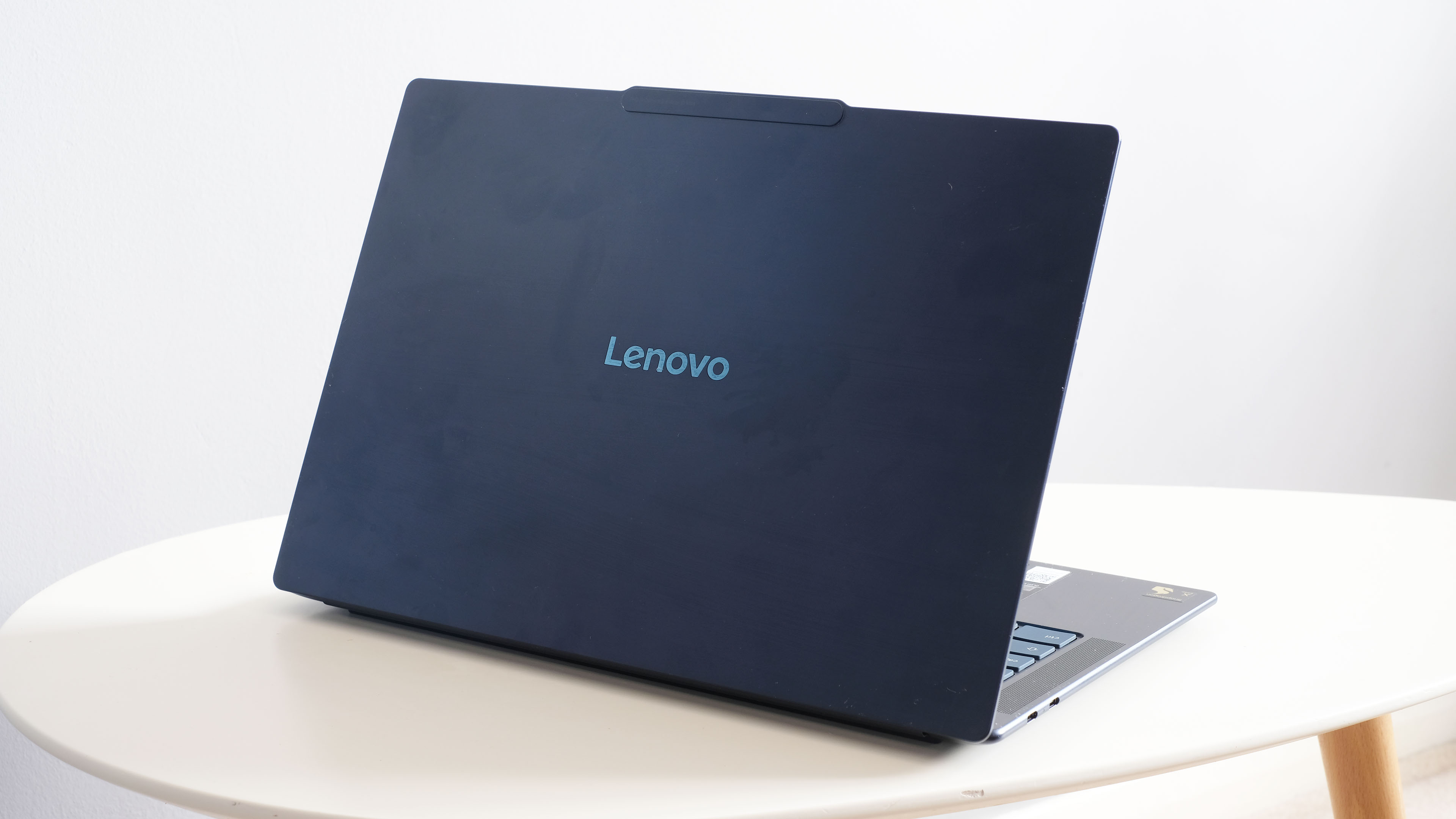
The Lenovo Yoga Slim 7x is part of a super-long-standing series of laptops that made its name in the era of the rise of the hybrids. But this isn't a laptop-tablet hybrid.
It has a touchscreen and the hinge lets the screen fold back by almost 180 degrees, but no-one's claiming a Yoga Slim 7x is going to like-for-like replace a tablet.
The build is that of a classic luxury laptop. All the main body panels are metal, using a bunch of recycled aluminium. Not too long ago less metallic-feeling magnesium alloys were all the rage, but the sustainability angle of recycled aluminium gives it extra kudos these days.

This laptop weighs 1.28kg. It's not ridiculously light, but is absolutely thin and light enough for a travel-heavy life. The hinge has the sturdiness to avoid annoying screen wobble should you work with the Lenovo Yoga Slim 7x on your knees too.
Lenovo gets a lot right here. I don't think the webcam lozenge Lenovo now puts into a lot of its laptops is particularly attractive though. Samsung's Galaxy Book Edge 4 is perhaps a little slicker than the Yoga Slim 7x. That Samsung’s screen section is also more rigid. But this is an all-round good-looking and expensive-feeling PC.
The main reason to pause is whether you might prefer a larger 16-inch laptop. Those are great for day-long working, but are obviously larger (and usually heavier). The top larger options in the CoPilot+ class are the above Samsung and Microsoft Surface Laptop 7 (at 15in).
Lenovo Yoga Slim 7X review: Display

Standards among these first-wave "made for AI" laptops are so high that even the Yoga Slim 7x's brilliant OLED screen comes across ordinary in this company. It's a 14-inch OLED with a 3K resolution (that's 2844 x 1840 for those counting the pixels).
There's really nothing to complain about here. It's sharp. It's bright. Colour is rich but not overbaked. The maximum resolution of 90Hz doesn't quite match the best, which have 120Hz or even 144Hz displays, but that above-60Hz smoothness does make ample difference nonetheless.
Lenovo also hits back with one element you might not consider. I've noticed that a lot of laptops with high-end displays these days have a plastic top layer. And it's not the classic matte style either, but glossy plastic. It's likely used to reduce weight and cost, seen in the MacBook Air and "made for AI" Asus Vivobook S. The Lenovo Yoga Slim 7x has a good old glass screen finish. As glass is harder and more rigid than plastic, you see much less distortion in reflections, which is nice.
I also tested the screen to see how bright it can go. It hits 465 nits in ordinary conditions when maxed, but can reach 923 nits when displaying HDR content. That’s super-bright. You can’t take off those training wheels to unlock that scorching brightness whenever you like, but I could comfortably use this laptop outdoors for work.
Lenovo Yoga Slim 7X review: Keyboard & touchpad
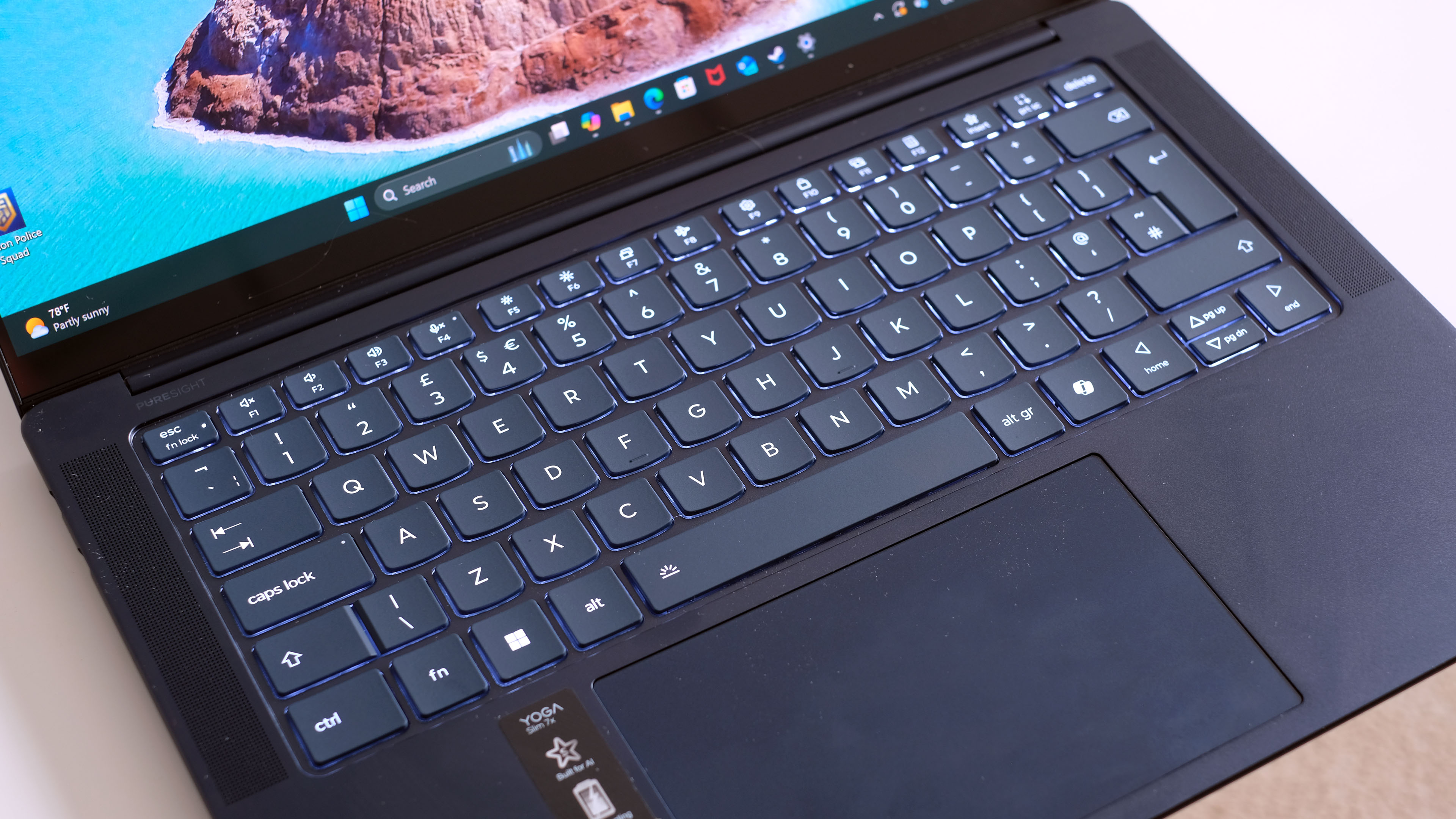
The Lenovo Yoga Slim 7x also has a much better keyboard than a lot of the first-wave AI PCs. These keys have far greater travel than those of a Samsung Galaxy Book Edge 16, and a bit more substance to their action than the also pretty deep dish Asus Vivobook S 16.
You can feel the DNA of the legendary ThinkPad keyboard in these buttons. And, sure enough, travel is above average (at 1.5mm). Lenovo also says there's a 0.3mm curvature to the keys, although the bit I notice more is that signature Lenovo shape, with a rounded-out bottom to each otherwise rectangular key.
This is a fab keyboard for long-form typing, one of my favourites of the year so far.
It has a backlight too, of course. It's a plain old white one, with two intensity levels, plus an Auto mode that turns it on when necessary. I'm not entirely sure this mode works in my specific laptop right now, though, as it stayed on when in a fairly bright train carriage.

The good stuff continues with the Lenovo Yoga Slim 7x touchpad. It's a legit glass pad, not plastic doing its best to masquerade as glass, seen in a depressing number of laptops pushing the four-figure mark or more these days.
It's not the tallest pad around, and the clicker feel is good rather than truly luxurious. But I still prefer its feel to that of the Samsung Galaxy Book Edge, which also has a lovely slab of glass. Lenovo doesn't mess around with any new-fangled haptic stuff here either, which can be hit-and-miss. This is a classic mechanical clicker.
Lenovo Yoga Slim 7X review: Performance
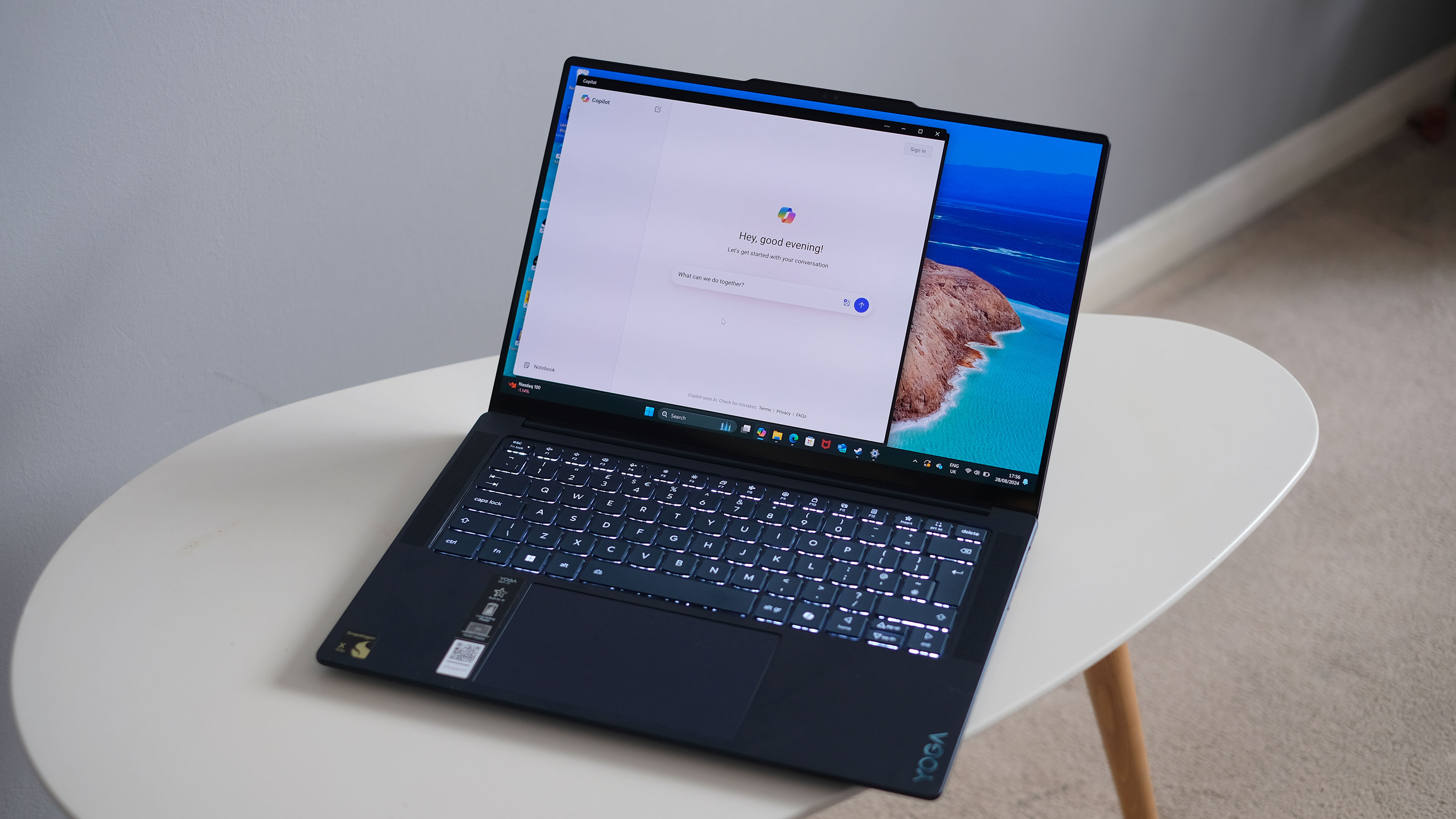
The Lenovo Yoga Slim 7x uses one of Qualcomm's Snapdragon X Elite processors. These are the heart and soul of these new AI PCs, because they have a punchy neural processing unit (NPU) that can handle some AI tasks without needing the help of cloud computing power.
Remember when Apple started using its own processors rather than Intel's back in 2020? This Snapdragon move is the closest Windows gets to that moment. And while the AI gumpf isn't worth upgrading for, boiling down to webcam effects, Microsoft Paint generative tools, and few other bits, these new chipsets are pretty compelling without it.
The Lenovo Yoga Slim 7x has raw power similar to that of the Intel Ultra-powered PCs we were reviewing in the weeks before the Snapdragon X Elite crew showed up. And while these new chipsets have a completely different processor architecture, you can treat Windows as normal.
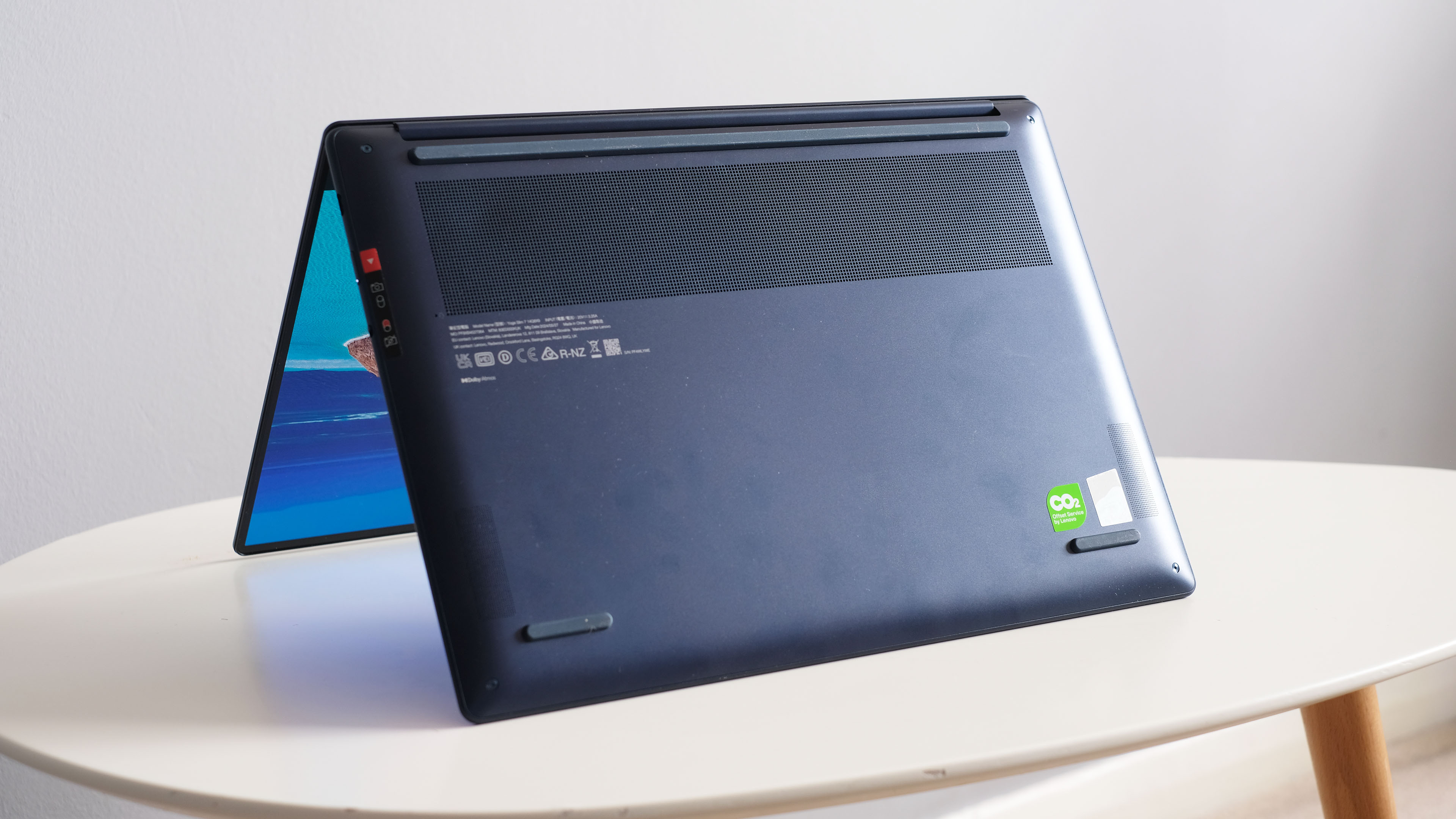
You can download apps like you usually would, install Steam and try out games, and so on. This isn't like previous Windows laptops that had phone-style Qualcomm processors. They weren't much cop at all.
Some of you will encounter issues though. These laptops don't seem to like peripherals that aren't 100% plug and play, and you should research before buying if there's a particular software package you'll need to use. But most, fingers crossed, shouldn't encounter many issues. I haven't in my Lenovo Yoga Slim 7x testing.
It’s also been silent during most of my testing although, unlike a MacBook Air, it does have a fan-based cooling system. And if you want to so some video editing or gaming, you will hear a pretty substantial whir. It’s a proper cooling system, not one just intended to stop a laptop flat-out overheating.
Can you game on a Yoga Slim 7x? Sure, within limits. I had to take a hatchet to Cyberpunk 2077’s settings to make it vaguely playable, and it made the game look pretty soft. Despite all the fuss about these AI processors, I’d probably still pick an Intel CPU model for gaming.
The best integrated GPUs of those chipsets still seem to be a bit more performant, and they seem to work better with Intel’s Xess upscaling – graphics upscaling is needed when you’re dealing with super-limited GPU power.
Lenovo Yoga Slim 7X review: Battery Life

While AI might be the headline benefit of the Lenovo Yoga Slim 7x's Snapdragon brain, its efficiency is perhaps the most meaningful benefit. I was able to get 19 hours of YouTube video playback out of the Yoga Slim 7x, at the sort of brightness you might use while indoors.
Lenovo says you can get up to 23.8 hours of use off a charge. It might be possible if you lower the screen brightness and do something even less demanding than video streaming. But 19 hours isn't to be sniffed at. It's more than two full days of work.
And with more demanding stuff? The Lenovo Yoga Slim 7x lasts at most two hours when playing Cyberpunk 2077. As I've seen with the other laptops in this class, they don't quite have the staying power under pressure of a MacBook.
The Lenovo Yoga Slim 7x's speakers don't quite match Apple's either. There is a small amount of bass. They aren't thin, though, and sound decent enough all considered. But they also don't have the sheer output or low-end punch of the best and are a little treble-heavy.
Lenovo hasn't gone overboard with the webcam either, despite it having its own lip in the screen surround. This is a 1080p webcam with fair to good image quality, beaten on specs by the rival Acer Swift 14 AI and its 5MP one. But for a Full HD one its image is pretty clean. Maybe we can thank AI for that.
Some of you will also be frustrated by the connectivity on offer, or lack thereof. Here we get three USB-C ports. That's it. Not even a headphone jack. Deeply annoying. But the USB-Cs are at least as high-spec as you could ask for, with 40Gbps bandwidth a piece and support for DisplayPort connections.
Lenovo Yoga Slim 7X review: Verdict
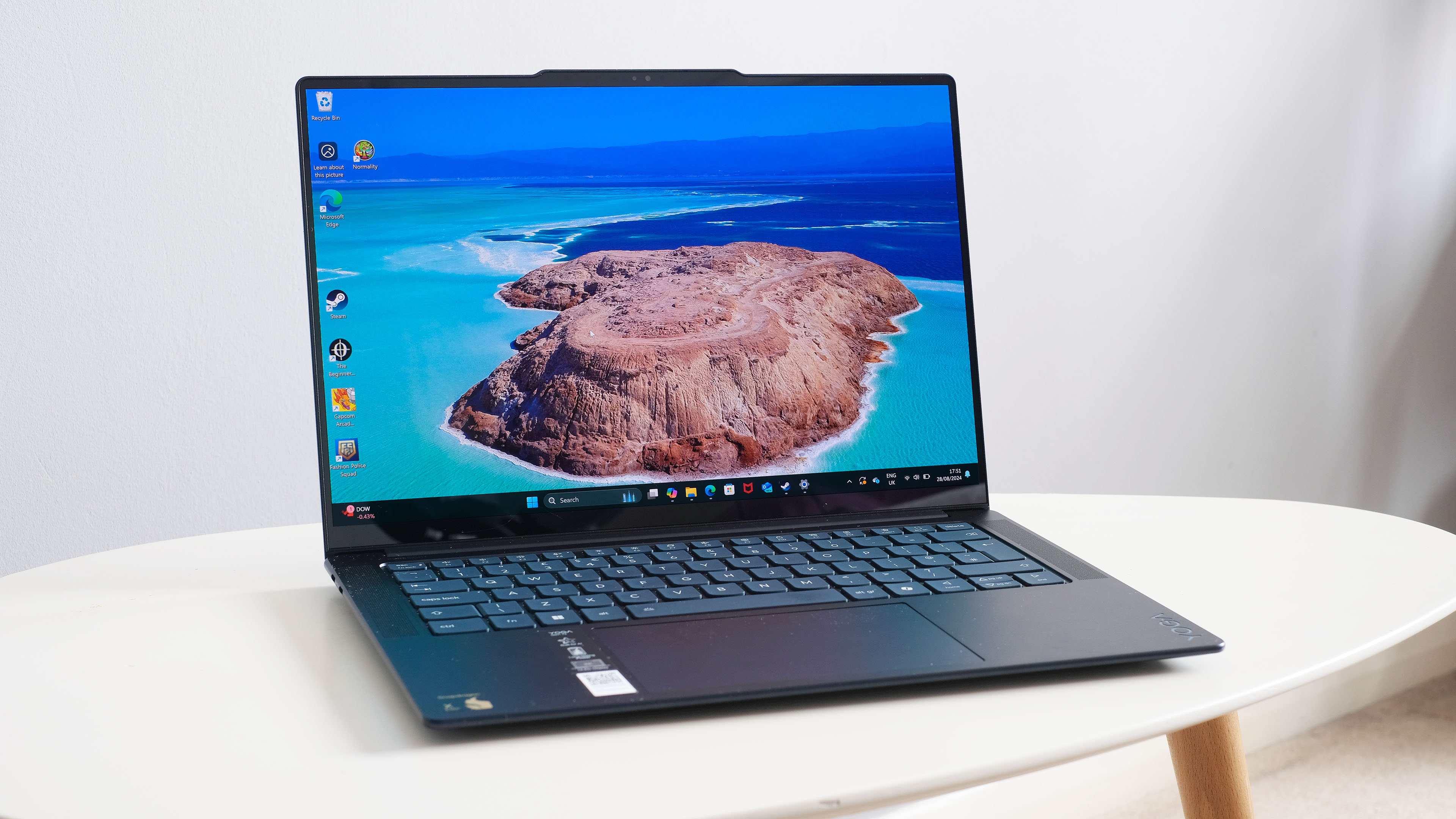
The Lenovo Yoga Slim 7x is the greatest, in a very limited and specific way. It's the best all-rounder in the first-wave of "made for AI" laptops with Qualcomm Snapdragon X Elite processors.
No wrong moves have been made: the screen, the design, the keyboard, the battery – nothing has been neglected. That sees the Yoga Slim 7x hit the perfect sweet spot when reflecting on price too.
Sure, the connectivity is limited, the speakers aren't world-beating, and whether you should actually want one of these PCs is still a question more pressing than it ever was with Apple's M1 MacBooks. Even so, Lenovo has come out on top.
Also consider
Okay, so you want a Snapdragon X Elite PC. What else is there? The most compelling reason to go for something else is if you decide you want a larger 16-inch model. Then your best option is the Samsung Galaxy Book Edge 4. It costs more, of course, and has a less substantial keyboard – but it's a brilliant larger option.
The Asus Vivobook S is also great, but uses a plastic touchpad. The Acer Swift AI as an alternative? It also has a plastic touchpad. But it's more cost-effective.
The Microsoft Surface Laptop is another top option, and the 13.8-inch model is actually more affordable than this Lenovo, surprisingly enough, but at its entry-level spec. Price it up to the level of the Yoga Slim 7x, though, and it costs a bunch more. Lovely touchpad, though.
The Microsoft Surface Pro is a compelling alternative if you want a hybrid that can also do stylus-led digital art. But then we're talking about a completely different style of PC. And different amounts of money, too.
Sign up to the T3 newsletter for smarter living straight to your inbox
Get all the latest news, reviews, deals and buying guides on gorgeous tech, home and active products from the T3 experts

Andrew is a freelance tech and entertainment journalist. He writes for T3, Wired, Forbes, The Guardian, The Standard, TrustedReviews and Shortlist, among others.
Laptop and computing content is his specialism at T3, but he also regularly covers fitness tech, audio and mobile devices.
He began writing about tech full time in 2008, back when the Nintendo Wii was riding high and smartphones were still new.
-
 Iconic foldable phone to get an update later this month
Iconic foldable phone to get an update later this monthMotorola is promising to revitalise its flip phone later in April
By Chris Hall Published
-
 Breitling adds two new Top Time chronographs celebrates the legacy of cycling legends
Breitling adds two new Top Time chronographs celebrates the legacy of cycling legendsThese are gorgeous watches
By Sam Cross Published
-
 Biver adds another two Automatique models to its collection
Biver adds another two Automatique models to its collectionThese are classy additions
By Sam Cross Published